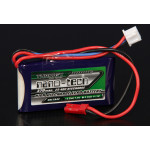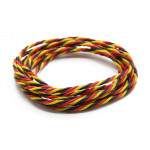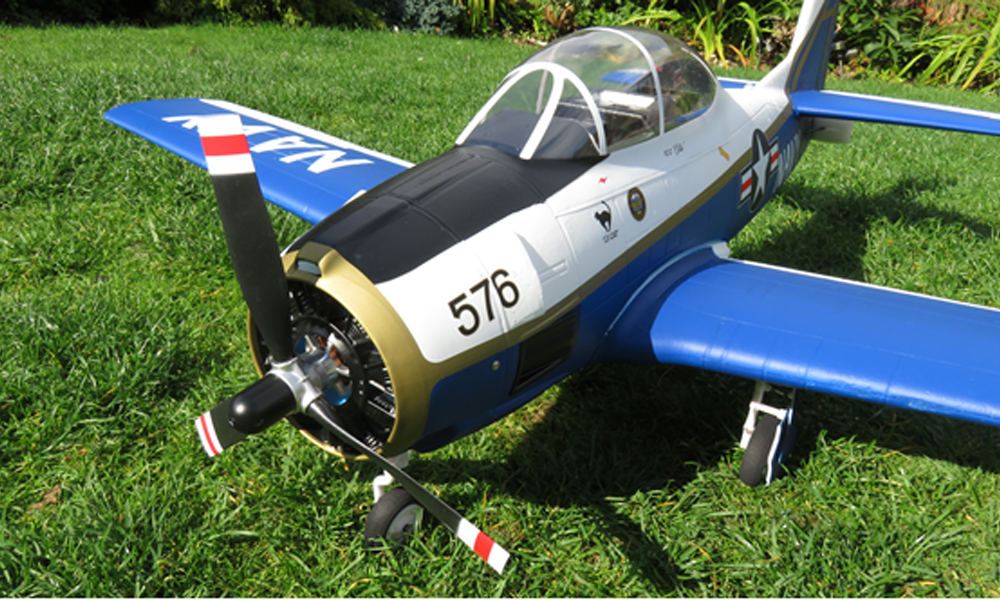
Introduction
The newly released T-28 Naval from Durafly isn't a new model design, but it does sport a lively new US Navy color scheme.
Its predecessor has been through a lot with me since I got my hands on it back in May 2017 so I was keen to get the new one to replace it when it's finally retired. That yellow version made it easy to spot on the ground and in the air and that huge bubble canopy and integrated FPV camera mount made it the ideal warbird to pop a camera inside and get a ‘pilots' eye view of what the inside of a T-28 looked like flying.
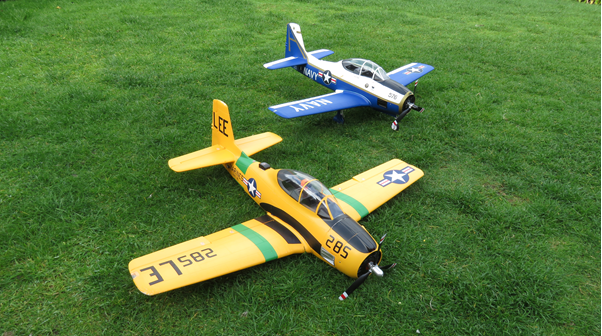
In fact on that original (duly dubbed the ‘yellow peril' by one of my flying buddies), I didn't stop there but went on to add an Eagletree flight controller so I could have a modern ‘heads-up display' on my FPV images (the Eagletree GPS is what you can see on the back of the yellow model, just aft of the canopy in the image). In this article, I'll be taking a look at the new shiny T-28 naval and looking at the features and specifications of this capable model.
Specifications
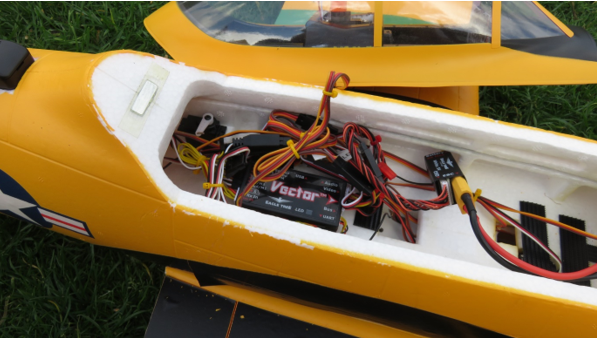
The model has a 1100mm (43") wingspan but looks a lot more imposing than other scale warbirds in this class. Compared to something like a Hurricane or Spitfire the body is spacious and the canopy huge; that extra ‘bulk' of the T-28 design that is very close to scale dimensions for this model makes the T-28 from Durafly appear a lot larger than it actually is. That extra size also means that inside you have lots of room for a battery and even a flight controller.
That huge bubble canopy is held on with magnets and once removed reveals that huge loading area underneath. No worries about being able to fit your battery choice here! Inside that canopy are a few nice scale details that do help with the immersive feel of any FPV flying you undertake. There is a recreation of the instrument panel and the plastics used in the canopy give a nice clear view out into the sky. You don't need to reach for the Exacto knife here to remove canopy plastics to see where you're going.
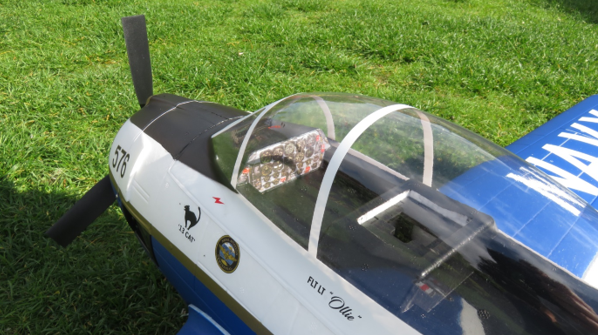
Those nice touches aren't just inside the canopy. On the outside of the body is that beautiful paint scheme, I think this is one of my favorite non-UK schemes from Durafly, and lots of beautiful scale touches everywhere. Even the moldings in the engine cowlings and the way that the prop nut finishes that supplied scale prop look great.
Power is supplied by a scale looking 10 x 6 3 bladed propeller attached to a 3536 750KV motor being run by a Durafly 45 amp speed controller and provides plenty of power. You'll need a 4S 2200mAh LIPO pack for power (sold separately). The wings include flaps and a working dive-brake; all of the servos are installed and seem decent quality. Also molded into the wings is the landing gear, as well as a nose, mounted the third wheel that's steerable too. Out on the tips of the wings and on the dorsal section are navigation lights so this will look like the part in lower light conditions.
Building
Building will take you about 20 minutes and most of that time will be spent screwing in the control horns into the control surfaces. The main wing comes as one piece and attaches to the prebuilt body with only four screws. The vertical tail and rudder are already molded into the body so all you need to do is push on the two halves of the horizontal stabilizer and secure them with a screw at each side. The bags of screws and parts are clearly labeled so even if you can't see a manual when you're building it's hard to go wrong.
What will take the time will be the setup of the receiver.
You'll need the usual 4 channels for the throttle, elevator, aileron, and rudder plus one for flaps. Then you'll also need one channel for the gear and one for the diving break and I'd also consider adding a separate channel for the front steerable gear wheel so you can change the range of movement to suit you. If you're going to add FPV then you'll also need an output for a pan servo too. That's an 8 channel receiver so I'm using a FrSky X8R in mine. You could use one with fewer PWM outputs but you'd have to sacrifice the dive break and the pan servo.
Flying
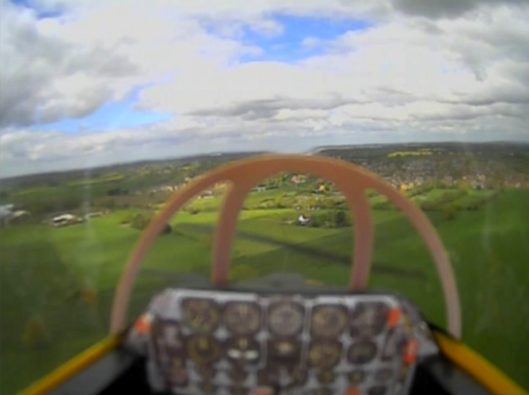
This model is a very stable flyer despite the scale looks and has plenty of power for loops, rolls, and more advanced aerobatics. It gets into the air quickly and has a reasonable speed envelope; just don't push it when you're going slowly. This isn't a Bixler! The large body and bright paintwork make it easy to keep orientation and that scale looks against the sky makes for a beautiful model.
There are times when I'm flying this T-28 that I forget it's a warbird and start to think of it as a trainer. But don't be fooled, open the throttle and use the higher rates and it'll flip and roll around the sky with the best of them. As with all of the scale models that landing gear will not cope with much more than very short grass. If you're thinking of this model then make sure that you've got access to a tarmac strip to land on, or a very smooth grassy area. Anything else will damage the gear and with the gear up the prop will foul on the ground so you'll damage that too.
FPV
The really nice feature of this model is how Durafly has molded-in and supplied the mounts for FPV out of the box. The above is an image from the original yellow version but should show you how cool it looks. The supplied balsa wood mount is designed for a 9g servo to be installed and act as a simple FPV pan setup and being able to look out over the wings during flight is a fun thing to do. Use a head tracker in your FPV goggles and you're starting to get into the realms of virtual reality, especially if you add a flight controller with a HUD.
Summary
This model will set up back about £160 here in the UK and about $209 US Dollars. It's one of the prettiest models I've seen in a while. Durafly has kept all of the things about the original that made it a great model and added that new vibrant color scheme.

For those who are not interested in FPV then the lack of a pilot model will be annoying. If you really want a pilot in the cockpit then they are cheap and easy to install onto the top of the FPV mount that comes in the box. But in my opinion, if you don't pop an FPV camera into that spot then you've missed one of the cool features of the model. It looks great LOS and it looks great FPV too. Not many models out there do both this well. All of the current models seem to be supplied with only one prop and no spares so I'd recommend ordering a spare prop as that's the thing most likely to get damaged. The front nose wheel does a great job of stopping ‘nose overs' on landing but if it gets caught on something it will cause the model to flip over.
Do remember that although this model is easier to fly than a lot of scale warbirds it's not a trainer. Make sure that you have a smooth area to land and take off and remember that any wheels up landings will probably damage the prop. So if it's nice and easy to fly would I recommend this for a beginner? I know I'll get asked this so let me cover this here; if you're looking to learn to fly get a Bixler V2 when you've mastered that and are looking for a scale warbird – strongly consider this.
Written by Painless360


